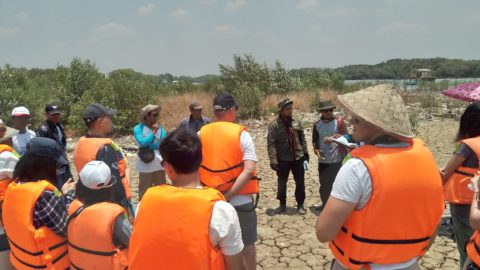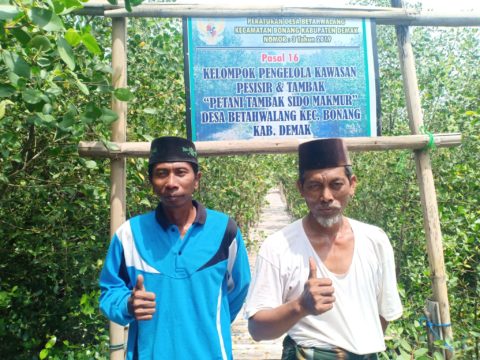
Collective Action to Address Mangrove Degradation
-
Coastal resilience
The Sido Makmur community group from Betahwalang Village is a clear example of the importance of collective action to overcome problems such as mangrove degradation. The coast of Betahwalang Village has experienced serious erosion for many years. This has led to a loss of aquaculture ponds. Given this situation, villagers were thinking of ways to improve the condition of their coastal area. When the Building with Nature programme entered Betahwalang Village in 2016, eligible residents joined in the hope that it would help them to rehabilitate mangroves on the coast of their village.
The head of the Sido Makmur community group, Ahmad Busyro, explains that the Building with Nature programme strongly motivated the group. The Bio-rights mechanism which engaged them in mangrove restoration in return for support to sustainable livelihood development, helped to change their attitude. From not being aware and caring for mangroves, they gained a high level of understanding and concern about mangroves and other coastal issues in their village. Ahmad also explained that besides obtaining training in natural mangrove rehabilitation, group members learned environmentally friendly aquaculture techniques. These best practices, known as Low External Input Sustainable Aquaculture (LEISA), eschew chemicals and instead use local natural materials such as micro-organisms and compost which can be produced by the farmers themselves. According to Ahmad, these practices have increased the productivity of group members’ aquaculture ponds.

“Before the BwN-Biorights program, the mangrove problem [in Betahwalang Village] was very complex, starting from the lack of concern about mangroves, ignorance of mangrove problems and lack of knowledge about the benefits of mangroves… The motivation of the program was remarkable for us because it changed our paradigm from those who don’t know to those who know.” – Ahmad Busyro


The Sido Makmur group also established an agreement with the programme to rehabilitate a 3.7 hectare area of coastal mangroves. At first, many in the village doubted the group’s ability to rehabilitate this mangrove area. But the group members did not give up and continued to work hard. After approximately four years, 16 hectares of the coastal mangrove area of the village had been successfully rehabilitated by the group, over four times the original target. The well-maintained rehabilitation sites managed to capture large and extensive amounts of sediment, and became suitable substrates for the natural growth of various species of mangroves. This area became a mangrove greenbelt that fortified the coast of Betahwalang Village, thereby protecting their land and ponds behind the greenbelt from erosion. This is a significant achievement and is something the group is very proud of, says Ahmad.
“What we consider spectacular is that from a plan to rehabilitate 3.7 hectares of mangroves, we were able to naturally regrow more than 16 hectares of mangroves. This is one of the achievements our group is very proud of. Before we started, many people doubted that we would succeed in rehabilitating the site.”
– Ahmad Busyro
Due to the group’s success in facilitating the growth and expansion of mangrove areas, the village government (i.e., the Village Head and the Village Consultative Body – Badan Permusyawaratan Desa) agreed to develop a village regulation to protect the mangrove greenbelt. This greenbelt area is now a place of learning and inspiration for various national and international parties from outside the Building with Nature programme, including, for example, a university from the United States. The Peat and Mangrove Rehabilitation Agency (BRGM), which is a government institution that leads mangrove rehabilitation activities in Indonesia, has also visited the greenbelt in Betahwalang Village. In addition, several parties have invited the Sido Makmur Group to collaborate on mangrove rehabilitation efforts, including from the provincial Forestry Service.
According to Ahmad Busyro, the success of the Sido Makmur Group in rehabilitating and expanding the village’s mangrove area cannot be separated from the cohesiveness and hard work of the group members. Equally important is the strong support from the government and other community members.
Building with Nature
From 2015 to 2021, a landscape-scale implementation of the Building with Nature approach was implemented in Demak district, Indonesia. We restored coastal and riverine mangroves to halt coastal erosion and boosted the local economy by introducing mangrove-friendly aquaculture practices. Besides engineering interventions, we engaged deeply with stakeholders to address the root causes of coastal breakdown and deliver multiple benefits to coastal communities.
Through the Bio-rights mechanism, we gave communities financial and technical support to change aquaculture methods or invest in alternative livelihoods in return for their active engagement in conservation and restoration and engaged them in village development planning.
